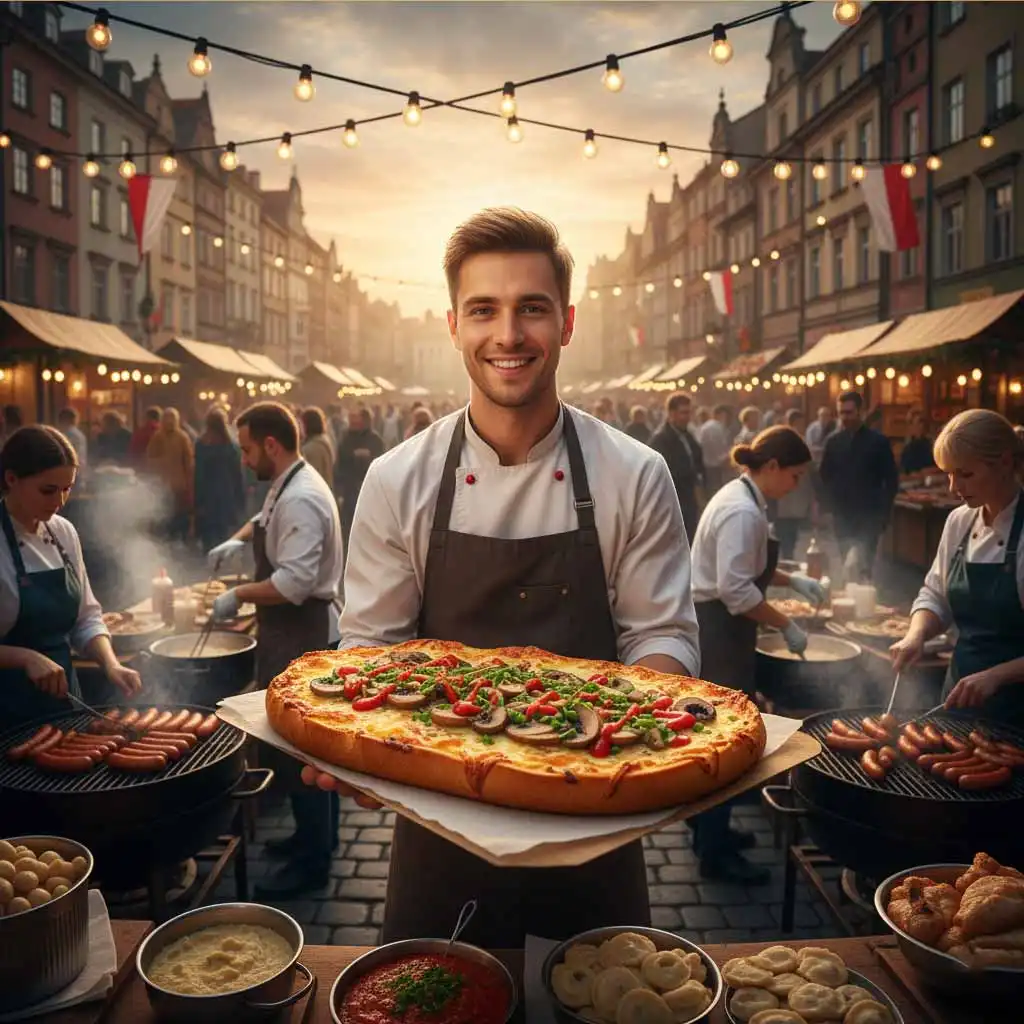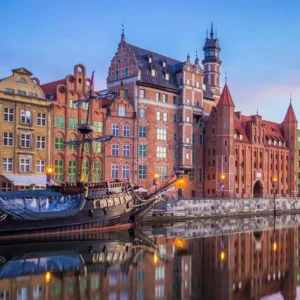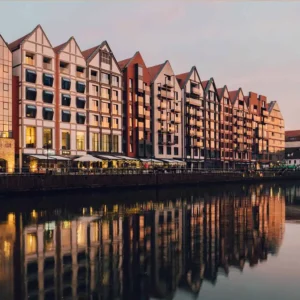Stepping onto the bustling streets of Poland, you are not just entering a country with a profound history and breathtaking architecture; you are embarking on an unforgettable culinary adventure. The aroma of grilled meats, savory spices, and freshly baked bread wafts through the air, drawing you into a world of flavors that is both rich in tradition and surprisingly innovative. This is the heart of Polish street food, a vibrant and essential part of the nation’s culture. This comprehensive guide will navigate you through the most delectable street food offerings, provide expert tips on how to find the best vendors, and help you experience this unique side of Polish life like a true local. Prepare to have all of your questions answered as we dive deep into the mouth-watering world of Polish street food.
The Cultural Heartbeat of Poland: Why Street Food is a Must-Experience
Polish street food is much more than a quick, convenient meal. It is a social ritual, a historical narrative, and a tangible connection to the country’s everyday rhythm. For many Poles, street food represents comfort, nostalgia, and a shared experience. As you move from one city to another, you quickly discover that each region boasts its own specialties and unique spins on classic dishes. The food stalls, trucks, and small kiosks are not just selling food; they are providing a glimpse into the soul of Poland. They are places where people from all walks of life gather, sharing stories and laughter over a hearty bite.
A Taste of History: From Communist-Era Staples to Modern Delights
The story of Polish street food is intrinsically linked to the country’s tumultuous history. During the communist era, street food often served as a practical, affordable means of sustenance. Dishes like Zapiekanka, a simple open-faced baguette, became incredibly popular due to their low cost and filling nature. These were not gourmet creations but rather resourceful culinary solutions born from necessity. Fast forward to today, and these same staples have been reimagined by a new generation of chefs and vendors. They honor the tradition while elevating the flavors and ingredients. You can now find classic street foods alongside gourmet hot dogs, international fusion cuisine, and sophisticated food trucks, creating a dynamic and exciting food landscape that reflects Poland’s evolution.
More Than a Meal: Street Food as a Social Experience
When you encounter a long queue at a Polish street food stall, do not be deterred. Instead, embrace it as part of the experience. The line itself becomes a social space. It is where you can observe locals, listen to the Polish language being spoken, and often receive a friendly tip on what to order. Street food vendors are often characters in their own right—passionate, knowledgeable, and proud of their craft. Engaging with them, even with a few simple Polish phrases, can add a layer of authenticity to your journey. This interaction transforms a simple transaction into a memorable moment. The experience connects you directly to the people and the culture in a way that a formal restaurant cannot.
Polish Street Food Did You Know?
The tradition of selling Obwarzanek from street carts in Krakow is a centuries-old practice. King John Albert granted the Kraków bakers’ guild a monopoly on baking these bread rings in 1496. This royal privilege solidified their place as a cultural icon of the city.
Essential Polish Street Food Dishes: Your Must-Try List
Exploring Poland’s street food scene requires a strategic approach. It is not just about eating; it is about knowing how to get the most authentic experience possible. This section will give you the inside scoop on the essential dishes and provide tips for finding the very best versions of each one.
Zapiekanka: Poland’s Answer to the Open-Faced Sub
Zapiekanka is perhaps the most iconic Polish street food. Originally a simple halved baguette topped with mushrooms and cheese, it has evolved into a customizable culinary canvas. For the most authentic experience, search for vendors that specialize in this dish.
- Tips for Finding the Best One: Avoid generic, tourist-heavy stalls and seek out places with a long line of locals. In Krakow, the best place to find a legendary Zapiekanka is at Plac Nowy in the Kazimierz district. The vendors located in the center of this circular market building have been serving them for decades.
- How to Customize Your Zapiekanka: The classic Zapiekanka is a foundation of mushrooms and melted cheese, typically drizzled with a generous amount of ketchup. Today, the possibilities are endless. You can add toppings like ham, spicy salami, chives, smoked cheese, or even vegetables like corn and peppers. Many stalls have a list of pre-set combinations, often named after famous Polish cities or historical figures.
- Best Cities to Try It: While you can find Zapiekanka all over Poland, Krakow, particularly Plac Nowy, is widely considered the spiritual home of the dish.
Obwarzanek: The Krakow Bread Ring You Can’t Miss
Often mistaken for a bagel, the Obwarzanek is a distinctively Polish bread ring, a protected regional food in Krakow. It is a braided dough ring, parboiled and then baked, resulting in a chewy, moist interior and a slightly crispy, golden-brown crust.
- Tips for Buying Fresh: You will see these sold from small, glass-fronted carts on nearly every street corner in Krakow. The key to a good Obwarzanek is freshness. When buying one, a good tip is to perform a light “tap test” on the crust. It should have a slightly firm, hollow sound, not a soft or spongy feel.
- What to Eat It With: Obwarzanek is most commonly sprinkled with salt, poppy seeds, or sesame seeds. It is a simple snack, best enjoyed on its own as you walk and explore. These are not meant to be eaten with spreads or fillings; their beauty lies in their simplicity.
Kiełbasa: The Ultimate Polish Grilled Sausage
Kiełbasa, the quintessential Polish sausage, is a staple of Polish street food. While you will find it on restaurant menus, the best way to experience it is from a street vendor grilling it over a smoky fire.
- How to Find a Genuine Stand: For an authentic taste of Krakow’s culinary history, seek out the legendary “blue van” (or “Nysa van”) in the Hala Targowa area, near Grzegórzecka Street. This unassuming stand has been serving grilled Kiełbasa from an old communist-era van for decades, attracting locals and tourists alike. The smoky aroma is a telltale sign you have found the right place.
- Best Types of Kiełbasa to Try: The most traditional street food version is Kiełbasa z rożna, a grilled sausage served with a simple roll and a dollop of mustard. It is a no-frills, incredibly satisfying meal.
- Serving Suggestions and Traditional Pairings: The sausage is typically served whole, with a piece of bread and a choice of mustard or ketchup. Embrace the minimalist approach. The smoky flavor of the sausage is the star of the show.
Polish Street Food Fun Fact:
The Kiełbasa from the “blue van” in Krakow has become such a cultural institution that it has been featured in international travel guides and news articles, with some calling it one of the most authentic street food experiences in all of Europe.
Oscypek: Smoky Cheese from the Tatra Mountains
Oscypek is a protected regional product, a spindle-shaped smoked cheese made from salted sheep’s milk. While it originates in the Tatra Mountains, you will find it sold by vendors in tourist areas, especially in Krakow.
- The “How-To” of Enjoying Oscypek: The best way to eat Oscypek is to have it grilled or fried until the outside is golden and slightly crispy, while the inside becomes soft and gooey. It is almost always served with a spoonful of tart cranberry jam, which provides a perfect counterpoint to the cheese’s salty, smoky flavor.
- Authenticity Tips: The genuine product has a distinctive spindle shape and a decorative pattern from the wooden molds used to press it. Be wary of imitations. True Oscypek is only produced from late April to October, so if you see it being sold outside this window, it may not be authentic.
Paczki: The Legendary Polish Doughnut
Paczki are not just doughnuts; they are a national obsession. These deep-fried, rich pastries are filled with various jams or creams. They are a decadent and essential part of Polish culture.
- When and Where to Find the Best Paczki: The ultimate time to enjoy Paczki is on “Fat Thursday” (Tłusty Czwartek), the last Thursday before the beginning of Lent. Bakeries across the country open early and sell thousands of these treats, with lines often stretching down the street. You can find excellent Paczki year-round at local bakeries, which will always be superior to those from a supermarket.
- What Fillings to Look For: The most classic and traditional filling is rose jam (dżem różany), which has a distinctive, fragrant flavor. Other popular fillings include plum jam (powidła), raspberry jam (dżem malinowy), and various creams.
Knysza: Wrocław’s Hearty Kebab-Style Sandwich
While it might resemble a kebab, Knysza is a uniquely Polish creation from the city of Wrocław. It is a large, semi-circular bread roll, hollowed out and stuffed with a wide variety of fillings.
- Tips for a True Knysza Experience: The key to a great Knysza is the combination of warm, soft bread and a mountain of fillings. The most traditional version is a mix of vegetables (shredded cabbage, cucumbers, tomatoes, and onions) and a generous helping of garlic mayonnaise.
- How it Differs from a Traditional Kebab: Unlike a kebab, which typically features sliced meat from a vertical rotisserie, a Knysza often includes a variety of fillings beyond meat, such as fried potato patties, meatballs, or sausage. The sauces are also distinct, with garlic and mayonnaise-based dressings being the most common.
Polish Street Food Did You Know?
A traditional Polish feast for Christmas Eve (Wigilia) is entirely meat-free, featuring dishes like mushroom soup, various preparations of carp, and vegetable-stuffed pierogi. This is a testament to the long-standing vegetarian traditions within Polish cuisine.
Other Street Food Delights: Soups, Potato Pancakes, and More
Poland’s street food scene extends far beyond these main attractions. Keep an eye out for these additional treats.
- Żurek: A sour rye soup often served in a bread bowl, Żurek is a hearty and surprisingly tangy dish. While not strictly a street food, you will often find it at Christmas markets or street food festivals.
- Placki Ziemniaczane: Crispy potato pancakes, often served with a savory mushroom sauce or a dollop of sour cream. These are a simple, delicious, and filling snack.
- Smalec: A spread made from pork lard, often mixed with cracklings, onion, and herbs. It is served on a thick slice of rustic bread. While the idea might sound unusual, it is a traditional and flavorful snack.
Navigate Like a Local: Best Tips for Finding Street Food
Finding the best Polish street food is all about knowing where to look and how to approach the experience with confidence. Follow these tips to eat like a true local.
Street Markets and Food Truck Parks: Hubs of Culinary Action
Major Polish cities have designated areas where street food vendors congregate. These are the best places to find a variety of options in one location.
- Tips for Finding Local Markets: In Krakow, for example, the Hala Targowa area is a great place to start. Look for historic markets or squares that are not exclusively geared toward tourists. A quick online search for “street food market” or “food trucks” in your target city will usually yield several excellent options.
- How to Find Food Truck Parks: Many Polish cities now have designated food truck parks. These are vibrant, modern spaces where you can find everything from traditional Polish fare to international cuisine. They are social hubs, often with seating, music, and a lively atmosphere, making them perfect for an evening out.
The Art of the Milk Bar (Bar Mleczny): Budget-Friendly & Authentic
While not technically “street food,” Milk Bars are an essential part of the Polish culinary experience and a must for any food-focused trip. These government-subsidized canteens serve traditional, home-style Polish food at incredibly low prices.
- Tips for Ordering in a Milk Bar: Milk Bars offer fast-paced, no-frills service. The menus are often on a chalkboard or a sign above the counter, usually in Polish only. Be ready to order quickly and have cash on hand, as many do not accept cards. When you get your food, always say a simple “dziękuję” (thank you)—it’s always appreciated.
- How they Differ from Street Food Vendors: Milk Bars offer a different kind of experience. The food is more akin to a home-cooked meal, with options like pierogi, soups, and traditional meat dishes. The atmosphere is functional and communal, a stark contrast to the grab-and-go nature of street food.
Navigating Menus and Ordering: Essential Polish Phrases
A few simple Polish phrases can make a big difference in your street food experience. Locals will appreciate the effort, and it might even lead to a better conversation.
- A Mini-Phrasebook for Ordering Food:
- “Poproszę…” (Po-pro-sheh): “I would like…” This is the most polite and useful phrase. You can simply point to the item you want and say “Poproszę Zapiekanka.”
- “Dziękuję” (Jen-koo-yeh): “Thank you.”
- “Smacznego!” (Smatz-neh-go): “Enjoy your meal!”
- Tips for Dietary Restrictions: If you have dietary needs, knowing a few key phrases is helpful. “Jestem wegetarianinem” (Yes-tem veh-geh-tah-ree-ah-nee-nem) for “I am a vegetarian” (if you are male) or “Jestem wegetarianką” (Yes-tem veh-geh-tah-ree-ahn-koh) (if you are female). “Bez mięsa” (Bez meen-sah) means “without meat.”
Beyond the Basics: Advanced Polish Street Food Tips for the True Foodie
Once you have mastered the essentials, you can take your Polish street food journey to the next level. These tips will help you explore deeper into the country’s culinary traditions.
Pairing Your Food with Polish Drinks
A complete food experience includes the perfect beverage pairing. Polish cuisine offers some fantastic options to complement street food.
- Non-Alcoholic Pairings: Kompot is a traditional drink made from boiled fruit. It is a refreshing and slightly sweet non-alcoholic option that goes well with many savory street foods.
- How to Pair with a Local Beer or Vodka Shot: For a truly local experience, pair a grilled Kiełbasa with a cold Polish beer. The crisp, clean taste of a lager cuts through the richness of the sausage. A shot of chilled vodka, which is a staple of Polish hospitality, is often reserved for richer, heavier dishes like a savory soup or meat stew.
Seasonal Specialties: What to Look for Year-Round
The seasons and local traditions deeply influence Polish street food. Being aware of these specialties can enhance your trip.
- Tips for Finding Seasonal Dishes:
- Winter: Look for vendors selling hearty, warming dishes at Christmas markets. Grzane wino (mulled wine) and grzane piwo (mulled beer) are perfect for cold evenings. You will also find hearty dishes like bigos (hunter’s stew) and soups.
- Summer: Summer brings lighter fare and fresh produce. You might find stands selling fresh strawberries, grilled corn, or crispy, fried fish in coastal towns.
The Best Cities for Street Food: A Regional Breakdown
While many street foods are available nationwide, each major city has a unique street food scene and special atmosphere.
- Krakow: Known for its historic charm and vibrant food culture, Krakow is the undisputed king of Polish street food. Here, you will find the most authentic and celebrated versions of Zapiekanka, Obwarzanek, and the iconic “blue van” Kiełbasa. The Jewish Quarter (Kazimierz) is the main hub for street food stalls.
- Warsaw: As the capital city, Warsaw offers a more modern and diverse street food scene. You can find everything from traditional Polish vendors to international food truck parks. The city’s food halls and renovated markets are excellent places to explore new culinary creations.
- Gdańsk: With its rich maritime history, Gdańsk’s street food often features fresh seafood, such as grilled fish or seafood sandwiches. It is a great place to experience a different regional flavor of Polish cuisine.
Polish Street Food Fun Fact:
The name “Knysza” is believed to be a reference to the Polish word “knyszać,” meaning “to hide” or “to conceal,” alluding to how the fillings are hidden inside the large bread roll.
Frequently Asked Questions about Polish Street Food
Is Polish street food safe to eat?
Yes, Polish street food is generally considered safe to eat. Vendors in Poland are subject to hygiene regulations, and many have been operating for years with a loyal customer base. A good rule of thumb is to look for stalls with a high turnover of customers, as this indicates the food is fresh and popular.
How much does Polish street food cost?
Polish street food is very affordable. Most items, such as a Zapiekanka, a serving of Kiełbasa, or a hearty soup, typically cost between 10 to 25 Polish złoty (PLN), which is a great value for a filling meal. Of course, prices can vary depending on the city and the specific vendor, but it remains one of the most budget-friendly ways to eat.
Are there vegetarian or vegan options?
The Polish street food scene has become much more accommodating to vegetarian and vegan diets. While traditional dishes are meat-heavy, you can easily find vegetarian options. Look for Zapiekanka with a simple mushroom and cheese base, Pierogi Ruskie (stuffed with potato and cheese), or Placki Ziemniaczane (potato pancakes). Many modern food trucks also offer creative vegan alternatives.
What is the most famous street food in Poland?
The most famous street food in Poland is the Zapiekanka, an open-faced baguette topped with mushrooms, cheese, and other ingredients. Its historical significance as a symbol of Polish ingenuity during a time of scarcity gives it its iconic status.
What is a Milk Bar?
A Milk Bar, or Bar Mleczny, is a type of cafeteria-style restaurant that serves traditional Polish cuisine at a very low cost. Established during the communist era to provide affordable meals, they continue to be a popular option for locals seeking a taste of home cooking.
What is the difference between an Obwarzanek and a bagel?
An Obwarzanek is a traditional Polish bread ring from Krakow. Unlike a bagel, which is boiled before baking, an Obwarzanek is parboiled, giving it a distinctively chewy yet softer texture. It is also typically less dense than a traditional bagel.
Can I pay with a credit card at a street food stall?
While many vendors, especially in larger cities and at food truck parks, now accept credit cards, it is always a good idea to have some cash (in PLN) on hand. Smaller, more traditional stalls, like the famous “blue van,” often operate on a cash-only basis.
What is the best season to try Polish street food?
Polish street food can be enjoyed year-round, but each season offers a unique experience. Summer is fantastic for food festivals and enjoying meals outdoors, while the winter months, especially around Christmas, bring festive markets with warming drinks and hearty foods.
Is ketchup a traditional topping for Zapiekanka?
Yes, ketchup is a classic and very traditional topping for Zapiekanka. While many people now add a variety of sauces, a Zapiekanka topped with just ketchup and a sprinkle of chives is a purist’s choice.
What is the best city to start a street food tour in Poland?
Krakow’s concentrated and historic food scene makes it the perfect city to start a street food tour, as you can easily sample a variety of iconic dishes in a short amount of time. The atmosphere is simply unmatched.
Conclusion: Your Polish Street Food Journey Awaits
Poland’s street food scene is a vibrant tapestry that history, culture, and a deep-seated love for simple, hearty food have woven together. It is an experience that transcends mere consumption; it is an act of participation in a living, breathing tradition. From the classic Zapiekanka found in the heart of Krakow to the legendary Kiełbasa served from a blue van, each bite tells a story.
This guide is your key to unlocking those stories, providing you with the knowledge and confidence to navigate the bustling markets and lively streets. So, put on your walking shoes, bring an appetite, and prepare for a delicious culinary adventure that will leave you with a newfound appreciation for the rich flavors and warm spirit of Poland.
Back to the Polish Adventure!
Your journey is just beginning. Now that you’ve explored the secrets of this article, it’s time to return to your home base. Click the link below to dive back into our comprehensive Best Tips for Poland hub article, where you can find more incredible guides and keep planning your ultimate Polish adventure. We’ve got so much more to show you!


















